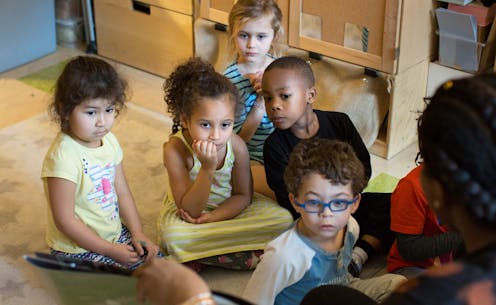
High-quality early childhood education and care services provide children with warm and nurturing interactions and ample opportunities for children to play, foster their intellectual and emotional growth and develop important social skills.
The constraints faced by disadvantaged families may reduce parents’ abilities to provide similar opportunities for growth at home, so it is not surprising that early childhood education and care has been shown to have the most positive impact for at-risk families.
Research has shown that unstable child care (for instance, children who shift from one care provider to another in a short period of time or who experience multiple arrangements simultaneously) is associated with negative outcomes, such as poor mental health and higher rates of aggression for children.
Our own research has found that a history of stable early childhood education and care may have buffered the negative mental health effects of the pandemic for some children.
A shift must be made in our society to prioritize giving all children, and especially children from low-income families, access to stable and high-quality early learning and care where they are able to flourish and grow. Yet Ontario’s subsidy policy for child care right now doesn’t prioritize stability of care for low-income families.
Mental health effects of the pandemic
We conducted a longitutinal study (of people over time) of 183 low-income mothers and their young children from Toronto. We examined children’s mental health changes from about two years before the pandemic and at the start of the pandemic, during its first eight or so months, beginning in spring 2020.
We wanted to try to understand why some kids were doing better than others early in the pandemic. At this point, children who were part of the study were in junior kindergarten to Grade 1.
In both phases of the study, parents reported on their children’s mental health using a mental health measure for children. With this data, we were able to create profiles of changes to mental health in response to COVID-19.
We found that 38 per cent of children experienced improvements in mental health after the onset of the pandemic. We found, after examining the data to eliminate other potential influencing factors, that this group of children were more likely to have a history of stable early learning and child care prior to the pandemic.

Some implications of our study
Our study adds evidence to existing research that demonstrates the important positive effects of stable learning and care for young children, and how this can serve as a protective factor in the face of major life stressors.
Current policies for early learning and child-care subsidies in Ontario increase the likelihood of education and care instability, and can have detrimental consequences for children.
Read more: Ontario's child-care agreement is poised to fail low-income children and families
Ontario’s subsidy system pays the difference between the total price of child-care services and parents’ contribution, as determined by a provincially established formula.
In Ontario, unlike some provinces, this is not a fixed percentage or a fixed amount. The absence of a cap on the maximum subsidy allows parents to choose high-quality early learning and care, regardless of the actual cost of care. However, access to a subsidized space is not a guaranteed right for Ontario families because of funding limits and space shortages.
Subsidies penalize changes in families
In Ontario, funding for subsidies is transferred from the province to the municipalities who oversee local service delivery.
The criteria for subsidy eligibility vary somewhat by municipality. In Toronto, for example, to receive early learning and care subsidies, parents must work full time, go to school full time or have a child considered to have “special needs” as outlined in the Child Care and Early Years Act.
Parents can lose their subsidy for any number of reasons unrelated to their need for one, for example, if they lose their job, go on parental leave because they have had another child, or quit their job to care for other family members.
For low-income families, the loss of a subsidy means the loss of the child-care space, which in Ontario costs on average $14,000 for a preschool child, and up to $19,100 for a child below 18 months of age.
For families, losing a subsidy creates instability in care for children, which means the loss of friends, routines and educators with whom they formed bonds, and causes drastic disruptions to young children’s lives.
These losses are especially difficult for children from poorly resourced families whose parents may be dealing with stressors like a job loss or the birth of another child.

New agreement hasn’t fixed problem
The new Canada-Ontario early years and early learning and child-care agreement, for the $12-a-day price, does not alleviate the problem outlined above.
Low-income families who cannot afford the reduced fees will be subjected to punitive restrictions imposed by the existing subsidy rules. This is not only grossly unfair, but also counterproductive given the benefits of stable, high-quality care for children from disadvantaged families.
Policies around subsidies must adopt this perspective and not penalize families for circumstances that are often outside of their control.
Samantha Burns receives funding from Social Sciences and Humanities Research Council.
Michal Perlman receives funding from Social Sciences and Humanities Research Council and the City of Toronto.
Calpanaa Jegatheeswaran, Petr Varmuza, and Sumayya Saleem do not work for, consult, own shares in or receive funding from any company or organisation that would benefit from this article, and have disclosed no relevant affiliations beyond their academic appointment.